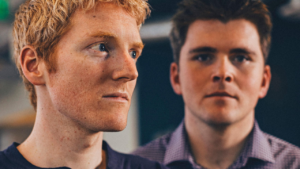From Idea to Billion-Dollar Company: The Melanie Perkins Story as Canva CEO
Whether you’re a blogger, marketer, or business owner, you have surely used Canva as a go-to tool for creating stunning graphics for your business or personal projects. But did you know that behind this powerful design tool stands a fabulous young woman whose creativity and vision have transformed how people approach visual communication?
At just 30 years old, Melanie Perkins became one of the youngest female tech unicorn founders when her company, Canva, was valued at $1 billion only five years after its launch in 2013. As Canva continues to expand and pursue ambitious goals, the company’s valuation rapidly increases, making her the most successful founder in Sydney since Atlassian.
Today, Canva is valued at a staggering $25 billion, making it one of the most successful startups in history and one of the earliest to quickly reach this level of success. She has also committed to donating her 30% ownership in Canva to charitable causes and intends to make a difference in the world by combating poverty. But behind these impressive numbers lies an incredible story of perseverance, creativity, and a passion for breaking down barriers in design.
In May 2021, Melanie Perkins was considered one of the wealthiest women in Australia, with a net worth of $6.5 billion. Then, she was honored by being inducted into the 30 Under 30 Hall of Fame in 2022 and, later on, was featured on Forbes’ Billionaires list for 2023. And this all despite not having a college degree.
Are you curious how Canva’s CEO, Melanie Perkins, transformed her small college startup in Australia into a global unicorn? If so, then keep reading.

Story behind: Why did Melanie create Canva?
Melanie Perkins’ journey to becoming the youngest self-made tech billionaire is awe-inspiring. Melanie was born in Perth, Australia, in 1987. She was always passionate about figure skating and would normally wake up at 4:30 a.m. every day for training. Engaging in sports instilled in her a mindset of setting and striving for objectives and cultivating an ambitious attitude.
At the age of 14, Perkins started her first business selling handmade scarves at markets and shops throughout Perth, which she considers to have developed her entrepreneurial drive.
After high school, Perkins enrolled in the University of Western Australia and studied Communications Psychology and Commerce. Simultaneously, she was working as a private tutor for graphic design students, where she, for the first time, noticed the difficulties students had in learning complex design programs such as Adobe Photoshop.
¨People would have to spend an entire semester learning where the buttons were, and that seemed completely ridiculous. I thought that in the future, it was all going to be online and collaborative and much, much simpler than these really hard tools.¨ shares Melanie in the interview with CNBC International on how the whole idea came up.
Her concept involved developing a design platform that did not require any technical expertise from people. But back then, Melanie and her future husband, slash business partner, Cliff Obrecht, didn’t have enough resources and technical expertise to develop a complex design software, so they decided to start with a specific product category – high school yearbooks – and founded their first company, Fusion Books in 2007.
Fusion Books: the predecessor to Canva
At just 19 years old, Melanie Perkins left university to follow her entrepreneurial ambitions and established her first business venture, Fusion Books.
The idea behind Fusion Books was to provide an online platform for creating and publishing yearbooks. The thing is that Melanie’s mother worked as a teacher and put a lot of dedication and hard work into creating those yearbooks. Seeing this, Melanie and Cliff collaborated to develop software to simplify the yearbook creation process. They decided to offer the software for free, with schools paying for the printed copies of the yearbook only.
Melanie and Cliff didn’t possess the knowledge of coding, but that didn’t stop them from pursuing their dream of revolutionizing yearbook creation. With the help of Greg Mitchell, the founder of a software development company called InDepth, they secured an AUD 50,000 friends and family loan and contracted InDepth to create the first version of their software, Fusion Books.
¨My mum’s living room became my office, and my boyfriend became my business partner. We started enabling schools to create their yearbooks really, really simply. So the whole year could collaborate and design their profile pages and articles. And then we would actually physically print them and deliver them to schools all around Australia.¨ says Melanie in an interview with CNBC International.
In the first year, 16 schools signed up for Fusion Books. Melanie and Cliff continued to pour their hearts into their dream, adding more schools and growing their business rapidly. By the end of the third year, they had 100 schools using their software. Over five years, Fusion Books experienced tremendous growth, becoming the largest platform of its kind in Australia and even expanding its reach to New Zealand and France.
Despite achieving remarkable success with Fusion Books, Melanie never lost sight of her “crazy, big dream” of creating a comprehensive all-in-one design platform. Her vision was to integrate the entire design ecosystem into one easy-to-use website accessible to the entire world.
Her unwavering determination and passion drove her to seek out investors, and she met Bill Tai, a Silicon Valley investor who happened to be in Perth.
How did Melanie’s encounter with Bill Tai and success with Fusion Books influence her “crazy, big dream” of creating an all-in-one design platform? Let’s see.
The art of selling your idea in the tech capital
Melanie’s chance encounter with Bill Tai, a legendary venture capitalist from Silicon Valley, changed the trajectory of her life. After speaking with him briefly at a conference in Perth, Tai invited her to meet with him in San Francisco to discuss her “crazy, big dream” of creating an all-in-one design platform. Despite initial doubts about Tai’s interest, Melanie was courageous and came to San Francisco. She presented a paper pitch deck on the future of publishing that impressed him enough to introduce her to others and invite her to his unique retreat for investors and kitesurfing enthusiasts, Mai Tai.
“So every time he would say, ‘How was my business going?,’ he’d also be like, ‘How’s your kitesurfing going?’ So I kind of needed to learn to kitesurf. I had not done it before. And, to be honest, it’s not something that I would normally, naturally try. But yeah, decided to give it a go because when you don’t have any connections, you don’t have any network, you just kind of have to wedge your foot in the door and wiggle it all the way through.” shares Melanie at the interview.
During this time, the seeds for Canva began to sprout, growing out of their previous venture, Fusion Books. Perkins and Obrecht relentlessly pursued investors, refining Canva’s concept with every “no” they received.
Finally, Bill Tai said he would invest in Melanie’s project, but only if she found a solid tech team, and so he introduced Melanie Perkins to Lars Rasmussen, the co-founder of Google Maps and Google Wave, who immediately understood the potential of Melanie’s vision for real-time collaborative editing.
“When I met with Lars, we had an incredible conversation and talked about the future of publishing and the future of the world. And he said he’d become our tech advisor. But what that actually entailed was a year of him rejecting every single person that I brought him. Sending him resumes, sending him LinkedIn profiles, bringing him physical people, and he was just like, ‘No, they’re not up to scratch.’ Which was incredibly frustrating at the time because I just wanted to get started!” adds Melanie.
Her persistence yielded results when she discovered Cameron Adams and Dave Hearnden, both from Google, who agreed to join the team as co-founder and CTO, respectively. In 2012, after months of hard work and dedication, Canva’s first funding round was oversubscribed, and the company received an initial investment of $1.6 million from investors and $1.4 million matching funding from the Australian government, which recognized the potential of Melanie’s vision and the value it could bring to the country’s economy.
The following year, the website was launched, allowing users to generate diverse online designs at no cost.
The rise of Canva: From startup to industry leader
After five years of pitching to investors, facing countless rejections, and pivoting engineers, the team finally launched the platform in 2013. Melanie Perkins was only 26 years old when she became CEO and co-founder of Canva.
However, her initial joy was short-lived as a journalist broke the embargo and wrote negative reviews about Canva, shattering Melanie’s world. Despite this setback, eventually, Canva picked up steam and began attracting positive attention from the press and community worldwide. The platform’s growth has been nothing short of phenomenal as Canva continues to expand its reach globally.
Since then, Canva has achieved great success, securing multiple investment rounds from various investors, including Felices, Blackbird Ventures, Sequoia Capital China, T. Rowe Price, and many others.
Led by the three founders, Melanie Perkins, Cliff Obrecht, and Cameron Adams, Canva has achieved incredible success, with a current estimated annual revenue of $1 billion and a dedicated team of over 3,400 employees known as ‘Canvanauts’. Its employees have given glowing reviews of the company on Glassdoor, with an overall employer rating of 4.4 out of 5, and 89% of reviewers are likely to recommend Canva to a friend.
Canva has also been honored with numerous industry awards, such as:
- “Overall Design Collaboration Company of the Year” at the 2021 RemoteTech Breakthrough Awards,
- Ranked 3rd on Forbes’ “Cloud 100” list
- Ranked 4th on CNBC’s Disruptor 50 list in 2022.
- Recognized as the 10th most innovative company in the world by Fast Company, joining other top companies like SpaceX, Microsoft, and Stripe.

Why is Canva so successful?
Canva became successful regarding the fact that you can effortlessly craft a staggering array of graphic materials – from eye-catching posters, stunning presentations, and engaging social media posts to sleek business cards, practical worksheets, helpful calendars, irresistible book covers, compelling planners, persuasive business proposals, and the list goes on and on. Canva is a versatile creative tool that empowers users to bring their design ideas to life without having any technical knowledge.
So, if you´re a business or startup, you don´t have to go out and pay hundreds of dollars to design brochures or business cards. You can use Canva instead, which is absolutely free. The free version offers over 250,000 free templates, 1+ million free photos and graphics, AI-powered design tools, and more. And if you want to scale up your business, for just $12.99 a month, you can enjoy unlimited access to 100+ million premium photos, videos, audios, and graphics. You can establish your brand´s visual identity with logos, colors, and fonts with up to 100 Brand Kits. You get more AI-powered design tools and more for creating content for your business. Isn’t it impressive?
Is Canva still popular?
Absolutely yes. According to recent statistics, Canva has a tremendous user base, with over 110 million people using the platform monthly. The company’s global design community is present in more than 190 countries, and Canva is among the top 100 most visited websites in at least 61 countries.
Today, the company is valued at approximately $25 billion, and Melanie’s net worth is $3.6 billion. Her story is a testament to the power of hard work, determination, and never giving up on your dreams.
Bottom Line
Melanie Perkins is a true inspiration for entrepreneurs to turn a dream into a goal, to persuade it, and never give up no matter how many rejections you get along the way or what the journalists might write about you. What made Melanie Perkins so successful? Despite facing countless challenges, Melanie remained focused on her vision and worked tirelessly to make Canva a reality. Her unwavering dedication and perseverance have led to the creation of one of the world’s most successful design platforms.






